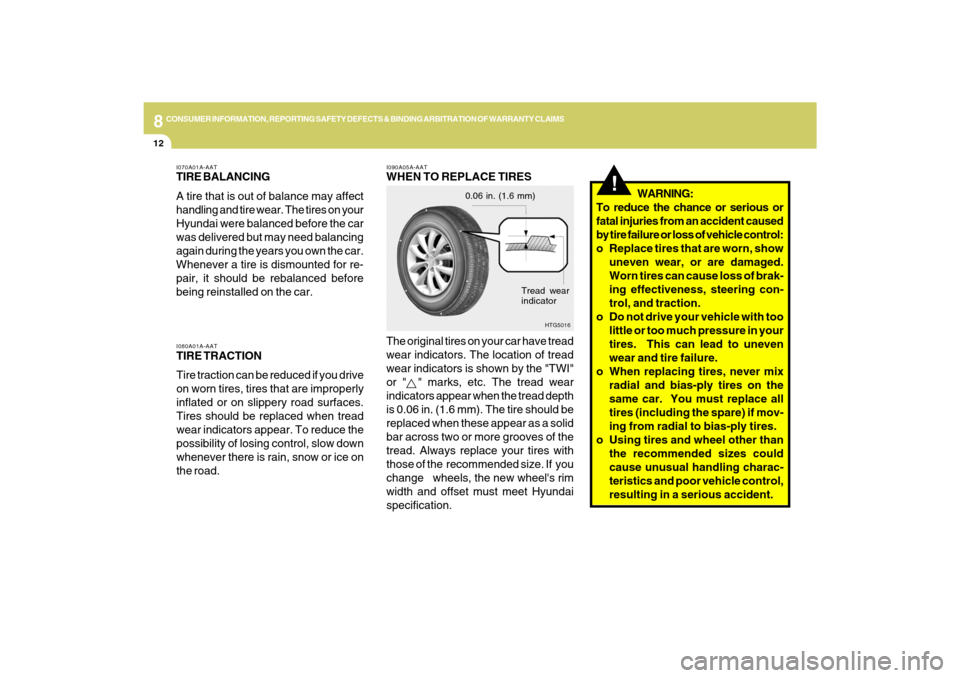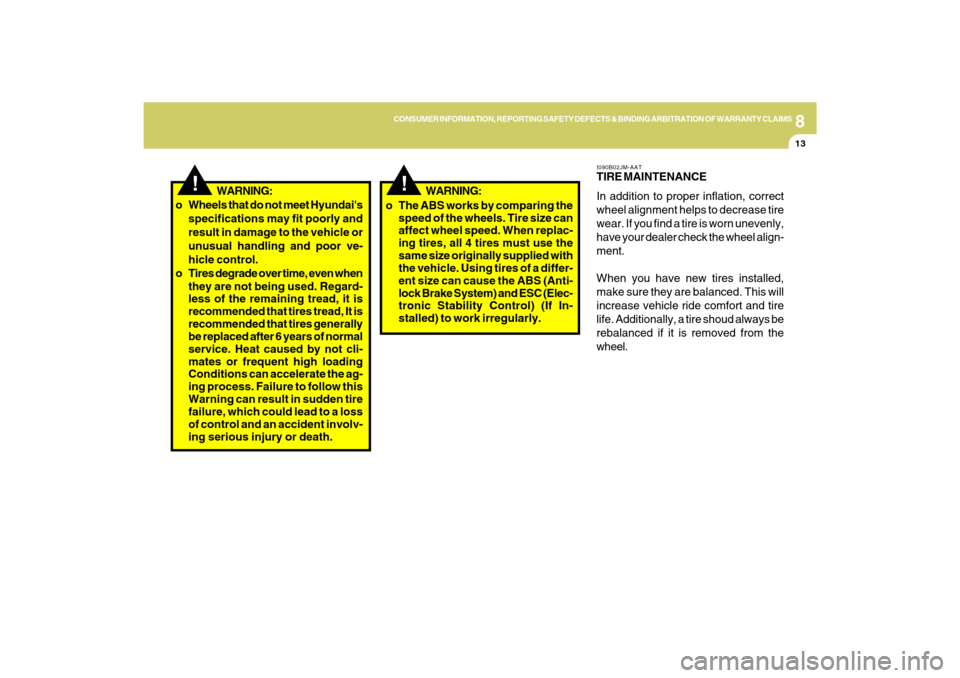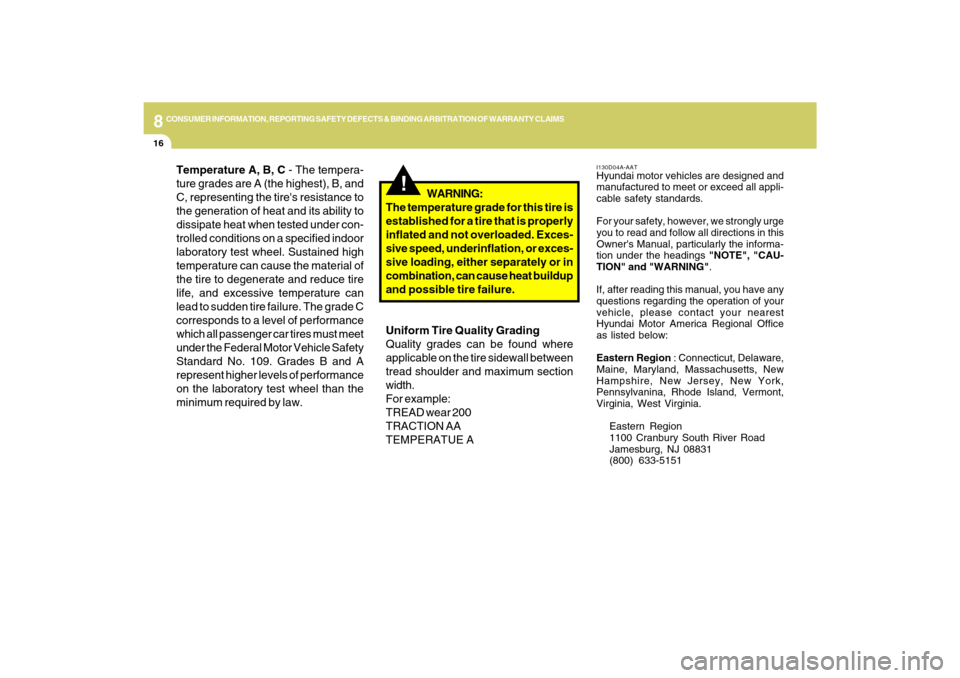2009 Hyundai Azera flat
[x] Cancel search: flatPage 315 of 335

8
CONSUMER INFORMATION, REPORTING SAFETY DEFECTS & BINDING ARBITRATION OF WARRANTY CLAIMS
9
Occupant Distribution: Designated
seating positions.
Outward Facing Sidewall: The side of
an asymmetrical tire that has a particu-
lar side that faces outward when
mounted on a vehicle. The side of the
tire that contains a whitewall, bears
white lettering or bears manufacturer,
brand and or model name molding that
is higher or deeper than the same mold-
ings on the other sidewall of the tire.
Passenger (P-Metric) Tire: A tire used
on passenger cars and some light duty
trucks and multipurpose vehicles.
Recommended Inflation Pressure:
Vehicle manufacturer's recommended
tire inflation pressure as shown on the
tire placard.
Radial Ply tire: A pneumatic tire in
which the ply cords that extend to the
beads are laid at 90 degrees to the
centerline of the tread.
Rim: A metal support for a tire upon
which the tire beads are seated.Sidewall: The portion of a tire between
the tread and the bead.
Speed Rating: An alphanumeric code
assigned to a tire indicating the maxi-
mum speed at which a tire can operate.
Traction: The friction between the tire
and the road surface. The amount of
grip provided.
Tread: The portion of a tire that comes
into contact with the road.
Treadwear Indicators: Narrow bands,
sometimes called "wear bars," that show
across the tread of a tire when only 2/32
inch of tread remains.
UTQGS: Uniform Tire Quality Grading
Standards, a tire information system
that provides consumers with ratings
for a tire's traction, temperature and
treadwear. Ratings are determined by
tire manufacturers using government
testing procedures. The ratings are
molded into the sidewall of the tire.Vehicle Capacity Weight: The number
of designated seating positions multi-
plied by 150 lbs. (68 kg) plus the rated
cargo and luggage load.
Vehicle Maximum Load on the Tire:
Load on an individual tire due to curb
and accessory weight plus maximum
occupant and cargo weight.
Vehicle Normal Load on the Tire:
That load on an individual tire that is
determined by distributing to each axle
its share of the curb weight, accessory
weight, and normal occupant weight
and dividing by 2.
Vehicle Placard: A label permanently
attached to a vehicle showing the origi-
nal equipment tire size and recom-
mended inflation pressure.
Page 318 of 335

8
CONSUMER INFORMATION, REPORTING SAFETY DEFECTS & BINDING ARBITRATION OF WARRANTY CLAIMS
12
!
WARNING:
To reduce the chance or serious or
fatal injuries from an accident caused
by tire failure or loss of vehicle control:
o Replace tires that are worn, show
uneven wear, or are damaged.
Worn tires can cause loss of brak-
ing effectiveness, steering con-
trol, and traction.
o Do not drive your vehicle with too
little or too much pressure in your
tires. This can lead to uneven
wear and tire failure.
o When replacing tires, never mix
radial and bias-ply tires on the
same car. You must replace all
tires (including the spare) if mov-
ing from radial to bias-ply tires.
o Using tires and wheel other than
the recommended sizes could
cause unusual handling charac-
teristics and poor vehicle control,
resulting in a serious accident.
I080A01A-AATTIRE TRACTION
Tire traction can be reduced if you drive
on worn tires, tires that are improperly
inflated or on slippery road surfaces.
Tires should be replaced when tread
wear indicators appear. To reduce the
possibility of losing control, slow down
whenever there is rain, snow or ice on
the road.I070A01A-AATTIRE BALANCING
A tire that is out of balance may affect
handling and tire wear. The tires on your
Hyundai were balanced before the car
was delivered but may need balancing
again during the years you own the car.
Whenever a tire is dismounted for re-
pair, it should be rebalanced before
being reinstalled on the car.
HTG5016 I090A05A-AAT
WHEN TO REPLACE TIRES
The original tires on your car have tread
wear indicators. The location of tread
wear indicators is shown by the "TWI"
or " " marks, etc. The tread wear
indicators appear when the tread depth
is 0.06 in. (1.6 mm). The tire should be
replaced when these appear as a solid
bar across two or more grooves of the
tread. Always replace your tires with
those of the recommended size. If you
change wheels, the new wheel's rim
width and offset must meet Hyundai
specification.
Tread wear
indicator 0.06 in. (1.6 mm)
Page 319 of 335

8
CONSUMER INFORMATION, REPORTING SAFETY DEFECTS & BINDING ARBITRATION OF WARRANTY CLAIMS
13
!
WARNING:
!
I090B02JM-AATTIRE MAINTENANCE
In addition to proper inflation, correct
wheel alignment helps to decrease tire
wear. If you find a tire is worn unevenly,
have your dealer check the wheel align-
ment.
When you have new tires installed,
make sure they are balanced. This will
increase vehicle ride comfort and tire
life. Additionally, a tire shoud always be
rebalanced if it is removed from the
wheel. o Wheels that do not meet Hyundai's
specifications may fit poorly and
result in damage to the vehicle or
unusual handling and poor ve-
hicle control.
o Tires degrade over time, even when
they are not being used. Regard-
less of the remaining tread, it is
recommended that tires tread, It is
recommended that tires generally
be replaced after 6 years of normal
service. Heat caused by not cli-
mates or frequent high loading
Conditions can accelerate the ag-
ing process. Failure to follow this
Warning can result in sudden tire
failure, which could lead to a loss
of control and an accident involv-
ing serious injury or death.WARNING:
o The ABS works by comparing the
speed of the wheels. Tire size can
affect wheel speed. When replac-
ing tires, all 4 tires must use the
same size originally supplied with
the vehicle. Using tires of a differ-
ent size can cause the ABS (Anti-
lock Brake System) and ESC (Elec-
tronic Stability Control) (If In-
stalled) to work irregularly.
Page 320 of 335

8
CONSUMER INFORMATION, REPORTING SAFETY DEFECTS & BINDING ARBITRATION OF WARRANTY CLAIMS
14
!
SPARE TIRE AND TOOLSI100A01NF-AATYour Hyundai is delivered with the fol-
lowing:
Spare tire and wheel
Wrench bar (1)
Jack (2)
Wheel nut wrench (3)
Tool receptacle (4)
7I100A01NF-A
I110A01A-AAT
SHOP MANUALA Hyundai Shop Manual is available from
your authorized Hyundai dealer. It's writ-
ten for professional technicians, but is
simple enough for most mechanically-in-
clined owners to understand.
WARRANTIES FOR YOUR
HYUNDAI VEHICLEI120A03A-AATPlease consult your Owner's Handbook
& Warranty Information booklet for your
vehicle's specific warranty coverage.
WARNING:
o Underinflated or overinflated tires
can cause poor handling, loss of
vehicle control, and sudden tire
failure leading to accidents, inju-
ries, and even death. Always check
tires are properly inflated before
driving. Refer to pages 2-23 and 8-
3 for proper tire pressures and
further information.
o Driving on tires with no or insuffi-
cient tread is dangerous. Worn-
out tires can result in loss of ve-
hicle control, collisions, and in-
jury and even death. Worn-out
tires should be replaced as soon
as possible and should never be
used for driving. Always check
tire tread before driving your car.
Refer to this page for further infor-
mation and tread limits.
Page 322 of 335

8
CONSUMER INFORMATION, REPORTING SAFETY DEFECTS & BINDING ARBITRATION OF WARRANTY CLAIMS
16
Temperature A, B, C - The tempera-
ture grades are A (the highest), B, and
C, representing the tire's resistance to
the generation of heat and its ability to
dissipate heat when tested under con-
trolled conditions on a specified indoor
laboratory test wheel. Sustained high
temperature can cause the material of
the tire to degenerate and reduce tire
life, and excessive temperature can
lead to sudden tire failure. The grade C
corresponds to a level of performance
which all passenger car tires must meet
under the Federal Motor Vehicle Safety
Standard No. 109. Grades B and A
represent higher levels of performance
on the laboratory test wheel than the
minimum required by law.
!
WARNING:
The temperature grade for this tire is
established for a tire that is properly
inflated and not overloaded. Exces-
sive speed, underinflation, or exces-
sive loading, either separately or in
combination, can cause heat buildup
and possible tire failure.
Uniform Tire Quality Grading
Quality grades can be found where
applicable on the tire sidewall between
tread shoulder and maximum section
width.
For example:
TREAD wear 200
TRACTION AA
TEMPERATUE A
I130D04A-AATHyundai motor vehicles are designed and
manufactured to meet or exceed all appli-
cable safety standards.
For your safety, however, we strongly urge
you to read and follow all directions in this
Owner's Manual, particularly the informa-
tion under the headings "NOTE", "CAU-
TION" and "WARNING".
If, after reading this manual, you have any
questions regarding the operation of your
vehicle, please contact your nearest
Hyundai Motor America Regional Office
as listed below:
Eastern Region : Connecticut, Delaware,
Maine, Maryland, Massachusetts, New
Hampshire, New Jersey, New York,
Pennsylvanina, Rhode Island, Vermont,
Virginia, West Virginia.
Eastern Region
1100 Cranbury South River Road
Jamesburg, NJ 08831
(800) 633-5151
Page 333 of 335

10
INDEX
5
R
Rear Seat ...........................................................................1-25
Armrest ..........................................................................1-116
Folding rear seatbacks ...................................................1-25
Rear seatback safety lock ..............................................1-26
Warning...........................................................................1-26
Rear Window Curtain ......................................................1-117
Rear Window Defroster Switch .........................................1-86
Reporting Safety Defects ...................................................8-17
S
Seat.....................................................................................1-18
Front ................................................................................1-19
Rear.................................................................................1-25
Seat Belts ...........................................................................1-27
3-Point system ................................................................1-30
Adjusting your seat belt ..................................................1-31
Care of seat belts ...........................................................1-28
Pre-tensioner seat belt ...................................................1-40
Precautions.....................................................................1-27
Seatback Pocket ................................................................1-90
Speedometer......................................................................1-75
Starting Procedure ............................................................... 2-5
Steering Wheel Tilt & Telescopic ....................................1-117
Stereo Sound System ......................................................1-135
Sun Visor ..........................................................................1-114
Sunglass Holder ................................................................1-95
Sunroof...............................................................................1-90T
Tachometer.........................................................................1-74
Theft-Alarm System ............................................................1-11
Ticket Holder ....................................................................1-115
Tires
All season tires ...............................................................8-10
Balancing........................................................................8-12
Chains.............................................................................8-10
Changing a flat tire .........................................................3-11
Checking the inflation pressure ....................................... 8-5
If you have a flat tire .......................................................3-10
Information........................................................................ 8-2
Maintenance...................................................................8-13
Pressure............................................................................ 8-3
Replacement...................................................................8-12
Rotation...........................................................................8-11
Sidewall labeling.............................................................. 8-6
Snow tires .......................................................................8-10
Spare tire .......................................................................... 3-9
Terminology and definitions ............................................. 8-8
Traction...........................................................................8-12
Tire Pressure Monitoring System (TPMS) ........................... 3-5
Towing
A trailer (or vehicle) ........................................................2-20
Emergency......................................................................3-17
If your vehicle must be towed ........................................3-16
Transaxle
Automatic.......................................................................... 2-6
Automatic transaxle fluid checking ................................6-12